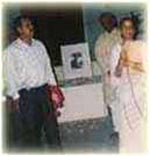
 The Artist
The Artist
Important Dates
Born On: 2nd April, 1931; Fatehpur(U.P.)
1952: M.Sc. Physics, University of Allahabad
1956: Head of Department of Physics, University of Allahabad
1990: Bhuvaneshwar Award
Died On: 8th July, 1989; America



 |
Agarwal's Sketches Impressive'From an estimate of his work, one feels that he has an eye for observation, as will be evidenced from some of his landscapes. They are convincingly fresh. In fact, he appears to have reached a certain height in landscapes and outdoor studies. They stand out prominently. Perhaps the most impressive are his sketches. Typical example of various manifestations of form, they are characterised by a charming sculptural elegance.' - Delhi Hindustan Standard Feb7. 1959 |

|
Landscapes A Strong Point'At first sight, the phenomenon of a scientist-artist may appear a strange one. But let us remember that the mind of art bloweth as it listeth. Bipin has much to comment him. He is working on the right lines. He has an eye for the essentials of form.His landscapes constitute his most refreshing work. The very way of handling paint which distracts in most of his other compositions, contributes to build up as well as create atmosphere. It is in a way reminiscent of Sailoz Mukerji, the veteran exponent of this impressionistic handling of the oil medium for the purpose of evoking a lyrical quality.' -The Times Of India Feb7. 1959 |
||
The Conflict On Canvas'Dr Agarwal's compositions are in effect a reflection of the multifaceted personality that he was. His self-portraits done in oil reflect this amply. In one he has highlighted the artist, scientist and writer in him while in the other he has sought to emphasise his inner character rather than seeking to achieve the photo painting effect. The landscapes done in thick colour with the aid of a knife also have a realistic dimension to them.Having spent his childhood in the hill areas, the scenic beauty of the mountainous terrain have found a representation in the paintings of the scientist.While on one hand the presence of graves amidst trees highlights the transitory existence of mankind, on the other the pristine beauty of nature has been depicted in some landscapes. The struggle between the conventional and the modern, the desire to break from the past and yet maintain a link with it, have been portrayed by Dr Agarwal in the modern style.' -The Pioneer, Mar31, 1993 |


|
|
 Home
Home Introduction
Introduction The Writer
The Writer The Scientist
The Scientist Painting Exhibitions
Painting Exhibitions